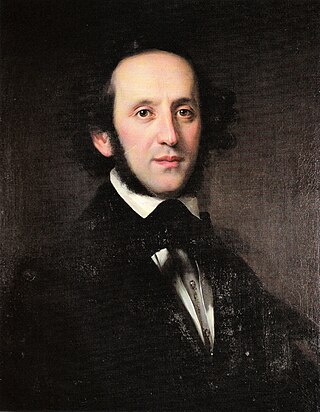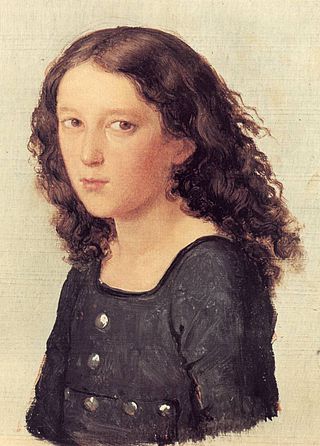Related Research Articles

Arcangelo Corelli was an Italian composer and violinist of the Baroque era. His music was key in the development of the modern genres of sonata and concerto, in establishing the preeminence of the violin, and as the first coalescing of modern tonality and functional harmony.

Sir Michael Kemp Tippett was an English composer who rose to prominence during and immediately after the Second World War. In his lifetime he was sometimes ranked with his contemporary Benjamin Britten as one of the leading British composers of the 20th century. Among his best-known works are the oratorio A Child of Our Time, the orchestral Fantasia Concertante on a Theme of Corelli, and the opera The Midsummer Marriage.
The concerto grosso is a form of baroque music in which the musical material is passed between a small group of soloists and full orchestra. This is in contrast to the solo concerto which features a single solo instrument with the melody line, accompanied by the orchestra.

A string orchestra is an orchestra consisting solely of a string section made up of the bowed strings used in Western Classical music. The instruments of such an orchestra are most often the following: the violin, which is divided into first and second violin players, the viola, the cello, and usually, but not always, the double bass.

The Violin Concerto in D major, Op. 35 was the only concerto for violin composed by Pyotr Ilyich Tchaikovsky. Composed in 1878, it is one of the best-known violin concertos.

Trevor David Pinnock is a British harpsichordist and conductor.
In music, variation is a formal technique where material is repeated in an altered form. The changes may involve melody, rhythm, harmony, counterpoint, timbre, orchestration or any combination of these.

Felix Mendelssohn's Violin Concerto in E minor, Op. 64, is his last concerto. Well received at its premiere, it has remained among the most prominent and highly-regarded violin concertos. It holds a central place in the violin repertoire and has developed a reputation as an essential concerto for all aspiring concert violinists to master, and usually one of the first Romantic era concertos they learn. A typical performance lasts just under half an hour.
Sinfonia concertante is an orchestral work, normally in several movements, in which one or more solo instruments contrast with the full orchestra. It emerged as a musical form during the Classical period of Western music from the Baroque concerto grosso. Sinfonia concertante encompasses the symphony and the concerto genres, a concerto in that soloists are on prominent display, and a symphony in that the soloists are nonetheless discernibly a part of the total ensemble and not preeminent. Sinfonia concertante is the ancestor of the double and triple concerti of the Romantic period corresponding approximately to the 19th century.
D minor is a minor scale based on D, consisting of the pitches D, E, F, G, A, B♭, and C. Its key signature has one flat. Its relative major is F major and its parallel major is D major.

David Matthews is an English composer of mainly orchestral, chamber, vocal and piano works.
Franciszek Zachara (b Tarnów, Austrian Poland (now Poland), 10 December 1898; d Tallahassee, Florida, United States, 2 February 1966) was a Polish pianist and composer who concertized extensively throughout Europe in the years leading up to 1928. He was a professor of piano at a Polish conservatory from 1922–1928, and two American colleges from around this time until his death in 1966. Zachara composed well over 150 works, including many works for piano solo, a piano concerto, a symphony, several works for band, and various chamber pieces. The archive of his manuscripts is held at the Warren D. Allen Music Library at Florida State University. Most of these manuscripts are originals (or copies) from the composer's own hand.
Divertimento for String Orchestra Sz.113 BB.118 is a three-movement work composed by Béla Bartók in 1939, scored for full orchestral strings. Paul Sacher, a Swiss conductor, patron, impresario, and the founder of the chamber orchestra Basler Kammerorchester, commissioned Bartók to compose the Divertimento, which is now known to be the pair's last collaborative work.

The Twelve Grand Concertos, Op. 6, HWV 319–330, by George Frideric Handel are concerti grossi for a concertino trio of two violins and cello and a ripieno four-part string orchestra with harpsichord continuo. First published by subscription in London by John Walsh in 1739, they became in a second edition two years later Handel's Opus 6. Taking the older concerto da chiesa and concerto da camera of Arcangelo Corelli as models, rather than the later three-movement Venetian concerto of Antonio Vivaldi favoured by Johann Sebastian Bach, they were written to be played during performances of Handel's oratorios and odes. Despite the conventional model, Handel incorporated in the movements the full range of his compositional styles, including trio sonatas, operatic arias, French overtures, Italian sinfonias, airs, fugues, themes and variations and a variety of dances. The concertos were largely composed of new material: they are amongst the finest examples in the genre of baroque concerto grosso.
The Musette, or rather chaconne, in this Concerto, was always in favour with the composer himself, as well as the public; for I well remember that HANDEL frequently introduced it between the parts of his Oratorios, both before and after publication. Indeed no instrumental composition that I have ever heard during the long favour of this, seemed to me more grateful and pleasing, particularly, in subject.
Michael Tippett's Concerto for Double String Orchestra (1938–39) is one of his most popular and frequently performed works.

The Symphony No. 2 by the British composer Michael Tippett was completed in 1957.
British composer Michael Tippett composed his Concerto for Piano and Orchestra between 1953 and 1955 on a commission from the City of Birmingham Symphony Orchestra. The overall character of the work was influenced by the composer's hearing German pianist Walter Gieseking rehearse Ludwig van Beethoven's Fourth Piano Concerto in 1950. Its musical content, while influenced by this concerto, was also shaped largely by Tippett's opera The Midsummer Marriage, which he had completed in 1952. While Tippett had conceived the work initially in the mid-1940s, he had been preoccupied in much of the intervening time with The Midsummer Marriage.

The Concerto for Piano, Violin, and Strings in D minor, MWV O4, also known as the Double Concerto in D minor, was written in 1823 by Felix Mendelssohn when he was 14 years old. This piece is Mendelssohn's fourth work for a solo instrument with orchestral accompaniment, preceded by a Largo and Allegro in D minor for Piano and Strings MWV O1, the Piano Concerto in A Minor MWV O2, and the Violin Concerto in D minor MWV O3. Mendelssohn composed the work to be performed for a private concert on May 25, 1823 at the Mendelssohn home in Berlin with his violin teacher and friend, Eduard Rietz. Following this private performance, Mendelssohn revised the scoring, adding winds and timpani and is possibly the first work in which Mendelssohn used winds and timpani in a large work. A public performance was given on July 3, 1823 at the Berlin Schauspielhaus. Like the A minor piano concerto (1822), it remained unpublished during Mendelssohn's lifetime and it wasn't until 1999 when a critical edition of the piece was available.
References
- ↑ Thomas Schuttenhelm, The Orchestral Music of Michael Tippett: Creative Development and the Compositional Process (London: Cambridge University Press, 2013) 117.
- ↑ Thomas Schuttenhelm, The Orchestral Music of Michael Tippett: Creative Development and the Compositional Process (London: Cambridge University Press, 2013) 118.
- ↑ Matthews, David (1980) Michael Tippett: An introductory study. Faber and Faber. p.60
- ↑ Bowen, Meiron (1988) CD Liner notes, VC 7 90701-2
- ↑ The Independent [ dead link ]